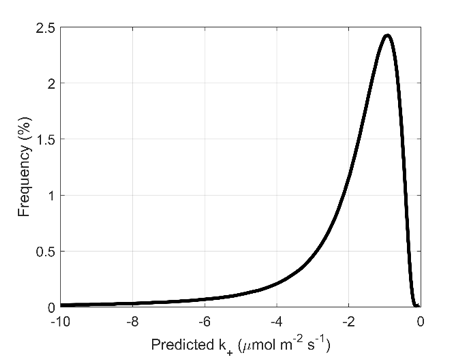Probabilistic Distribution of Belite Dissolution Rates

Distribution of local dissolution fluxes in pure water as extrapolated from measurements in a series of water-ethanol mixtures.
The probabilistic distribution of dissolution rates of polycrystalline beta-dicalcium silicate (β-C2S) in water and water-ethanol mixtures were measured by in-situ reflection digital holographic microscopy (DHM). DHM characterizes the nanoscale surface topography and its changes relative to an absolute height reference. Local and macroscopically averaged heights can be measured across the field of view every 80 ms, and the time derivative of height change can be estimated by finite differencing. Measurements were performed on polished polycrystalline surfaces of sintered C2S disks in which the β polymorph was stabilized by 3 % aluminum on a molar basis. Quantitative X-ray diffraction of the sintered specimens confirmed that the material was 88 % β-C2S, 8 % γ-C2S, and 4 % α-C2S.
DATA DOWNLOADS:
The data presented in the three text files, labeled cs_data.txt, k+_data.txt, and global_dissolution.txt, have two columns of values corresponding to the probabilistic distribution (histogram) data. In k+_data.txt, the first column is the frequency and the second column is the dissolution flux constant value in units of μmol m-2 s-1. In cs_data.txt, the first column is the frequency and the second column is the predicted number of reactive sites in percent. In global_dissolution.txt, the first column is the frequency and the second column is the global dissolution flux in units of μmol m-2 s-1.
All uncertainties associated with these data are discussed in an accompanying paper that is currently under review for publication.
Abstract for the accompanying paper:
The surface normal dissolution flux of beta dicalcium silicate is quantified using in situ digital holographic microscopy. The dissolution flux in flowing solutions depends on the water activity to an empirically determined power of 1.7. The heterogeneous distribution of reactive surface sites (e.g., crystalline defects) at the surface leads to a distribution of local fluxes. Accounting for the nominally non-reactive and slowly reactive surface sites, the median of the macroscopic dissolution flux distribution is -0.64 μmol m-2 s-1. Ex situ X-ray photoelectron spectroscopy indicates that the calcium-to-silicon ratio near the surface decreases by about 10 % after dissolution has taken place for more than 30 minutes.
Contacts
-
(301) 975-5944
-
Dr. Alexander S. Brand(630) 930-3856

